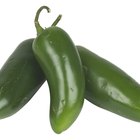Tomatillos (Physalis ixocarpa) are the key ingredient in salsa verde or green salsa. Tangy, crisp and juicy, tomatillos can be eaten raw, roasted or sautéed on their own or with a variety of herbs and spices.
Tomatillos grow on shrub-like vines that have a sprawling or erect habit, depending on the variety. They resemble paper lanterns, with a green or purple fruit inside a paper husk. Tomatillos are ripe when they are just bursting the paper husk, and are bright green or dark purple, depending on the cultivar. Tomatillos can quickly go from being ripe to splitting their skins, and are over-ripe if they have turned a pale yellow. Fully ripe tomatillos are usually 1 to 2 inches in diameter, with a tangy to sweet flavor. Under-ripe tomatillos do not fill the paper husk, may appear slightly shriveled and taste somewhat sour.
Origin and History
Tomatillos are native to Mexico, first domesticated by the Aztecs around 800 B.C. By the 1860s they were a naturalized commercial crop in California.
Grown as an annual in the United States, they are hardy in U.S. Department of Agriculture plant hardiness zone 4 and warmer, where you may start them inside six to eight weeks before the last frost. Tomatillos will ripen 75 to 100 days after transplanting, for a total growing time of 100 to 150 days.
Common Names
Tomatillos are sometimes called husk tomatoes or green tomatoes; like tomatoes (Solanum lycopersicum), they belong to the nightshade (Solanaceae) family, but they are a different genus and species. To further confuse matters, the term “green tomato salsa” or salsa verde refers to a salsa or sauce made with tomatillos, but some cooks also use unripe green tomatoes to make a green tomato salsa.
Other common names for tomatillos are ground cherries, miltomates, jamberberries and strawberry tomatoes.
How to Harvest
Fully ripe tomatillos are easy to pluck directly off the vine. If they require more than a slight tug, they may be under-ripe.
Store unhusked tomatillos in a paper bag in the refrigerator for up to two weeks. If you remove the husks, you can store them in the refrigerator for up to three months. With the husk removed, tomatillos are sticky, so wash them before consuming. You can also freeze whole fruits, cook the tomatillos into a salsa or roast them and preserve the cooked or roasted tomatillos or tomatillo salsa by canning.
Related Articles

How to Cook Tomatillos for Chili Verde

How to Soften Tomatoes

Are Buckeyes & Chestnuts the Same?

How to Remove a Cardamom Seed From a Pod

How to Tell When Okra Is Ripe

Facts About the Jalapeno Pepper

How to Oven-Dry a Bitter Gourd

How to Keep Brown Plantains Fresh

How to Remove Bitterness From Brussels ...

How to Blanch, Peel, & Freeze Whole ...

How to Roast Corn in the Husk
How to Roast Raw Cashews

How to make Stuffed Jalapeno Peppers ...

How to Eat Hazelnuts

How to Freeze Edamame Soybeans

The History of Butternut Squash

How to Preserve Nectarines

How to Use a Colander to Remove ...

How to Preserve Roasted Red Peppers

How to Blanch Cucumbers
Writer Bio
Lisa Jensen grows organic food and lives in an adobe house that she built. She teaches aikido, is an experienced back-country skier and backpacker and is active in her community. A graduate of the University of Calgary, Jensen writes about gardening, home projects, social sciences and sports and recreation.